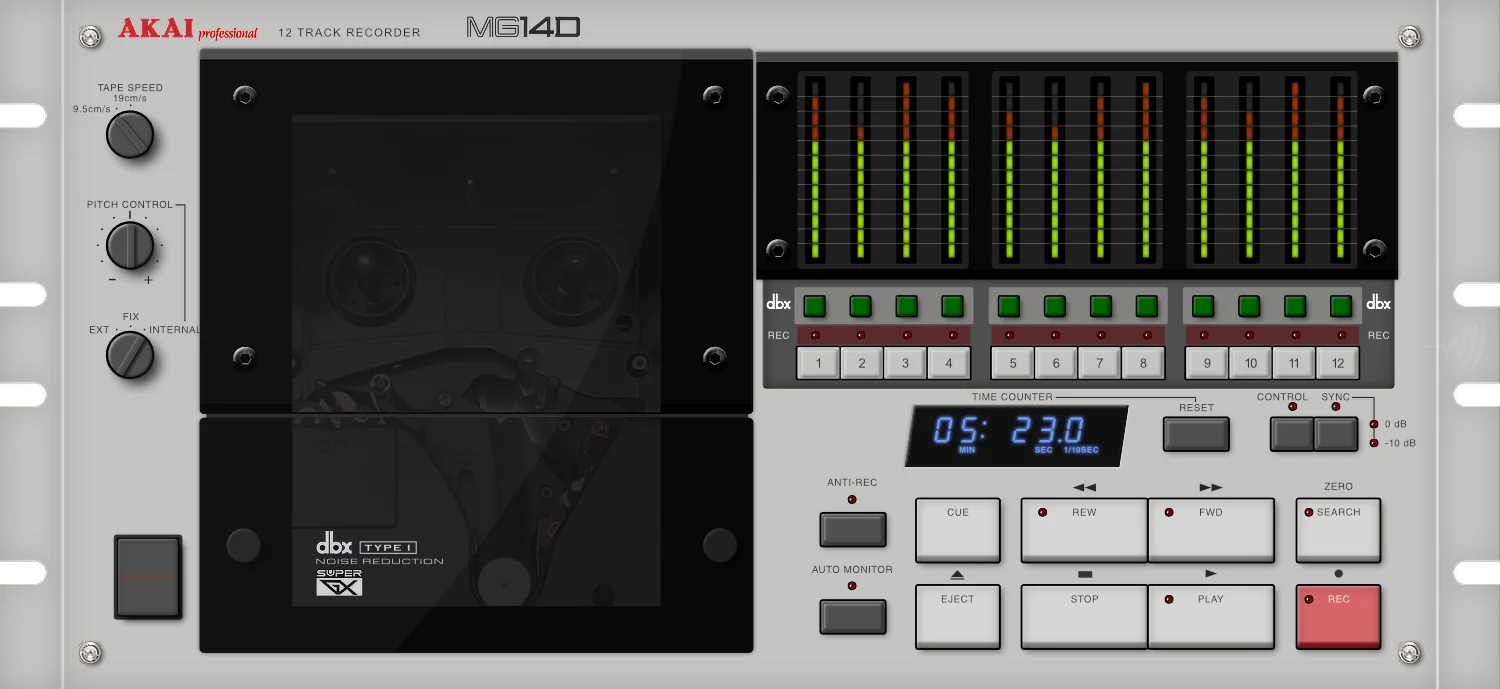As the 1980s ended, Akai who were enjoying their time in the sun with the massive success of their range of digital samplers, had turned their attention to recorders. By around 1987 they released the Akai MG14D, a tape-based recorder that was very unique and bespoke. It offered great sound quality with 12 tracks for a reasonable price point. The development had a number of hurdles to overcome but given Akai’s experience in high end consumer tape recorders, they made it work.
The Akai MG14D is a rack mountable tape recorder based on the recorder section of the Akai MG1214 with a dedicated sync and control track which made it suited for use with SMPTE and synchronisation with MIDI devices.
The Akai MG14D’s ability to lock up with SMPTE time code made this flexible compact multitrack also useful as a production tool for video, film, and sound effects assembly in addition to being a powerful music production tool. Adding the Akai ML14 Auto Locator gave you complete remote control over memory search, auto repeat, punch in/out with precision to 1/10the of a second. Memories in the Akai ML14 were retained for up to one week.
Features
- Uses 1/2 Inch Akai Original Tapes (MK20)
- Two Tape Speeds, 19 cm/s and 9.5 cm/s
- A +/- 1% Pitch Control is available
- DBX Type I noise reduction ensures professional sound quality
During the development phase of the Akai MG14D and its siblings, Akai was planning to use VHS tape to minimise cost of development, however there was a clause in the licensing of VHS which stated that the format could only be used for video products, or so the story goes. This begs the question; how did Alesis manage to use the VHS tape format in the ADAT? Perhaps by the time the ADAT was in development, JVC, the owner of the VHS format, had a change of heart.
Failing to secure VHS tapes for their new machines, Akia approached Sony to see if they could license the Betamax tape format, only to be turned down once again. This left them with one choice, which was to make their own tapes, which is exactly what they did.
The Akai MG14D and its siblings, were great machines, however the tape that Akai made for use on these machines…not so much. These tapes tended to shed the oxide which would cause audio dropouts and fill the machine with the oxide which was not a very good situation. To fix this problem, Akai approached the experts in tape, TDK, and managed to convince them to make the tapes for their systems, which proved to be a far better option and solved the issue of tape shedding.
The Akai MG14D Rack Mountable 12 Track Recorder is a high-performance durable rackmount unit ready to stand up to the rigorous demands of multitrack recording. The Akai MG14D represents a new direction in recording versatility with its compact rack mountable design and SMPTE compatibility
It utilises the same high quality Super GX multitrack recording head as used in the MG1214 as well as an improved loading mechanism to give you the same professional performance and operational features found on the Akai MG1214. Bar graph meters display the precise signal level on each recording track.
The Akai MG14D has 12 audio tracks as well as a sync track and an internal control track. With the use of SMPTE time code it is possible to synchronise your audio and video machines together as well as your MIDI based instruments and sequencers. With SMPTE compatibility the Akai MG14D can be used as a production tool for video, film, and sound effects assembly as well as a tool for creative music production in the recording studio. Combined with the matching ML 14 Programmable Auto Locator the capabilities expand into those of a full-fledged professional SMPTE based recording system capable of handling the most demanding work.
The ML 14 represents the state-of-the art in auto locating technology. All transport controls along with record and playback status can be controlled and viewed from the ML 14. In addition to providing you with total remote control of the Akai MG14D, it will add an exciting dimension to the operating capabilities.
Simple push-button operation of the Akai ML 14 Auto Locator’s controls yields such sophisticated computer-assisted functions as memory search, punch-in/punch-out, playback mute, repeat, and more. A ten key program pad lets you manually enter values into one of the memories for later recall. The memories in the ML 14 will be retained for as long as one week. The memory time and the time count are displayed on a highly visible 5-digit FL display.
While the Akai MG14D may be forgotten, you have to give Akai some credit for developing such a system, at the time they did, with digital recorders just around the corner. The Akai MG14D was a very well designed, and good sounding system, that is sadly all but forgotten.



